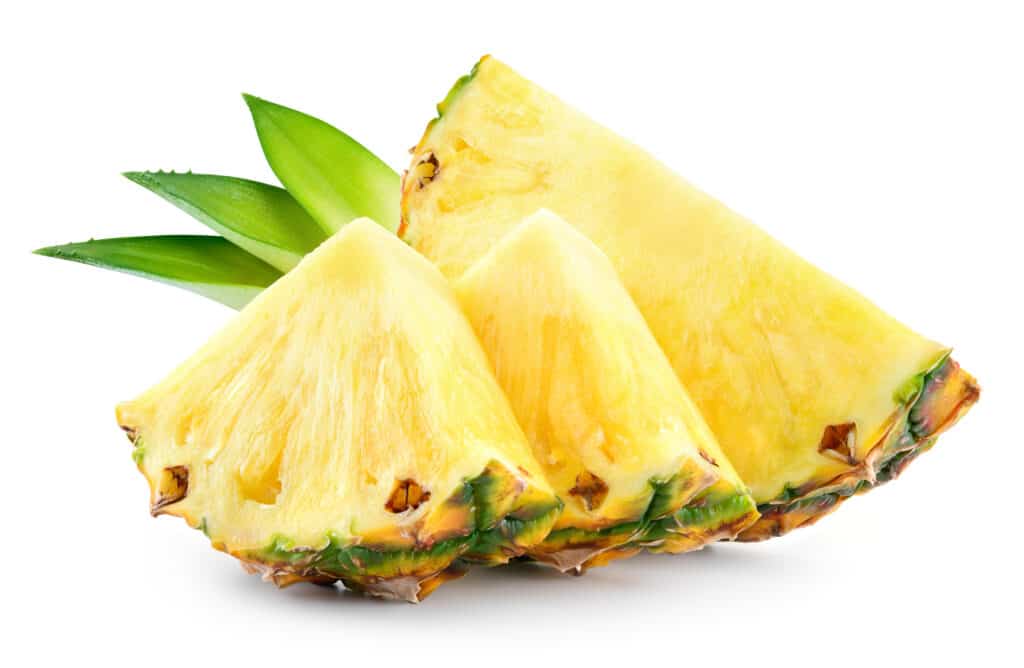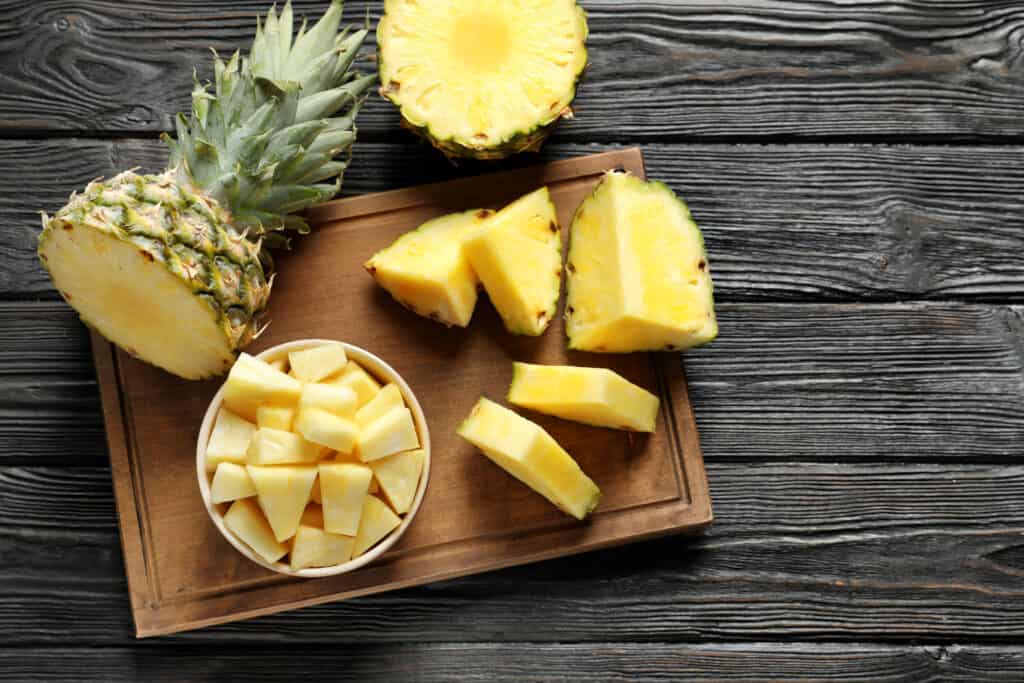The pineapple (Ananas comosus) is the most economically significant member of the Bromeliaceae family. It has short, stocky stems and stiff, waxy leaves. The pineapple is a South American native that has long been cultivated there. After being brought to Europe in the 17th century, the pineapple quickly rose to prominence as a cultural representation of luxury. Since the 1820s, pineapple has been produced for profit on a variety of tropical plantations and in greenhouses.
Although it may seem easy to categorize the well-known pineapple as a fruit, there are several interesting facts that expound on this more than the typical person tends to know. This article will address the question, “Is the pineapple a fruit or vegetable?” and provide some intriguing information that might surprise you!
So, Is Pineapple a Fruit or a Vegetable?

Pineapples usually produce up to 200 flowers whilst generating their fruit.
©Tim UR/Shutterstock.com
Pineapples are categorized as a fruit. In terms of determining whether they should be classified as a fruit or a vegetable, pineapples are actually rather straightforward to differentiate from other plant parts we consume. Although many people already know this, there is one fact about the type of fruit a pineapple is that just might surprise you. Keep reading!
The Pineapple Is a Collection of Berries!
The pineapple has a remarkably distinctive method of fruit production. The plant produces blooms, and as they ripen, they turn into multiple fruits. In actuality, the pineapple is a fruit that has developed from a variety of berries. This suggests that rather than being a single fruit, pineapples are a group of berries that have merged together. The technical terminology for this is a multiple fruit, composite fruit, or collective fruit!
It usually produces up to 200 flowers whilst generating its fruit, though certain large-fruited varieties might yield more. The ovaries develop into berries once it has bloomed, and the berries come together to create a large, dense, multi-fruit. Typically, the fruit of a pineapple is divided into two hexagonal shapes that interlock, each of which has a Cyclical number. For example, 8 in one direction, and 13 in the other direction.
Why Is Pineapple Considered a Fruit?
By closely examining one, you can begin to comprehend the elements that contribute to a pineapple’s common (and accurate) designation as a fruit. Fruits are the part of a plant that develops from the flower and carry the seeds, according to the botanical definition. The case of pineapple satisfies both of these conditions. However, the pineapple seeds are not located in the core, like in most other fruits, but rather near the edge of the fruit, close to the prickly skin!
The Pineapple From a Culinary Perspective

Pineapples are traditionally utilized for their sweet taste and are frequently used in baked items and sweet drinks.
©New Africa/Shutterstock.com
In the world of food, a fruit or vegetable is typically classified according to its flavor. Usually lacking in sweetness, vegetables are prized for their fibrous and earthy qualities rather than their juice. To extract its acidic and stimulating juice, pineapples—one of the sweetest fruits—are frequently pressed. They are traditionally utilized for their sweet taste and are frequently used in baked items and sweet drinks. Therefore, even in the culinary world, pineapple is termed fruit!
How Pineapple Is Used in Food and Drink Preparations
The juice and flesh of the pineapple are used in cuisines all over the world. In many tropical countries, prepared pineapple is sold as a snack by the side of the road. It is often served whole or sliced in half with a skewer inside. The Philippines has produced “nata de pina,” a traditional jelly-like dessert, since the 18th century. It is created through the fermentation of pineapple juice. Pineapple vinegar is present in many cuisines in Honduras and the Philippines because it is a locally produced item. It is usually prepared by blending pineapple juice with grain vinegar. However, the peels from the entire fruit are typically used in Mexico.
Whole, cored slices of pineapple are commonly paired with cherries in the middle. This pairing is often seen laid upon the top (or bottom, depending on how you look at it) of the infamous pineapple upside-down cake! Crushed pineapple is a common ingredient in ice cream, yogurt, jams, and pastries. In addition, it is used as a solitary drink (pineapple juice) and the principal ingredient in drinks such as pina colada and tepache. Pineapple chunks even go nicely with savory dishes like pizza toppings and grilled hamburgers and chicken!
Pineapple Health Benefits
Raw pineapple pulp contains 86% water, 13% carbohydrates, 0.5% proteins, and hardly any fat. It is a fantastic source of manganese and vitamin C. Pineapples also increase your daily recommended intake of copper, folate, iron, magnesium, niacin, potassium, riboflavin, thiamin, and vitamin B6. It is claimed to improve digestion, lower cancer risk, and increase immunity. It may even reduce inflammation, and possibly even hasten the healing process following surgery or intense activity!
Up Next:
Yes, Dogs Can Eat Pineapples. Here’s Why
Is Watermelon A Fruit Or Vegetable? Here’s Why
Is An Olive A Fruit Or Vegetable? Here’s Why
The photo featured at the top of this post is © baibaz/Shutterstock.com
Sources
- Healthline, Available here: https://www.healthline.com/nutrition/benefits-of-pineapple
- The Garden Hows, Available here: https://thegardenhows.com/is-pineapple-a-fruit/
- Garden And Me, Available here: https://gardenandme.com/is-pineapple-a-fruit-or-vegetable/
Thank you for reading! Have some feedback for us? Contact the AZ Animals editorial team.






